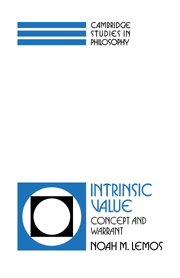Appendix A - Chisholm's definition of organic unity
Published online by Cambridge University Press: 07 May 2010
Summary
I wish to consider briefly Chisholm's attempt to define an organic unity. One merit of his approach is that it does not make use of the notion of a “sum” of values. In Brentano and Intrinsic Value, he offers the following definitions:
(D1) P is a part of Q = Df Q is necessarily such that (a) if it obtains then P obtains, and (b) whoever conceives Q conceives P.
(D2) Some of the goodness of G is defeated by W = Df. B is a good part of W and better than W; and if Whas a bad part that is worse than W, then that bad part is part of G.
(D3) Some of the badness of B is defeated by W-Df B is a bad part of W and worse than W; and if W has a good part that is better than W, then that good part is a part of B.
Given the definition of a part in (D1), every state of affairs is a part of itself. Thus, in (D2) and (D3) we should take the definition of “part” to refer to “proper parts.”,P is a proper part of Q if and only if P is a part of Q and Q is not a part of P.
The defeat of goodness can be illustrated by pleasure in the bad. Consider the state of affairs, Smith's being pleased that Jones is suffering.
- Type
- Chapter
- Information
- Intrinsic ValueConcept and Warrant, pp. 196 - 200Publisher: Cambridge University PressPrint publication year: 1994



